Explore the rich tapestry of history through these 15 iconic photos that have shaped our world. From monumental moments to poignant snapshots, each image in this collection tells a powerful story that has transcended time. These iconic photos have become symbols of eras, movements, and emotions, forever etched in our collective memory.
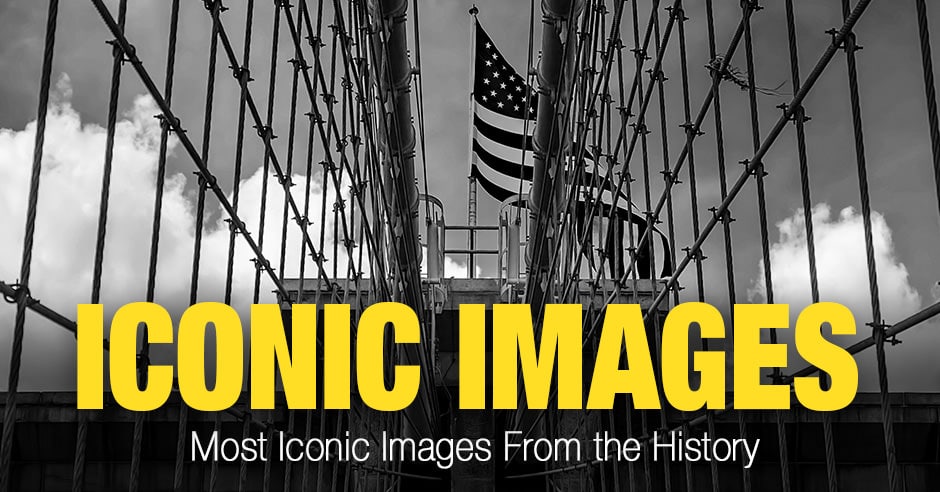
Table of Contents
What Makes an Iconic Photo?
What is an iconic photo? While most people will have a different definition or criteria for what makes an image iconic, they do have something in common. Most iconic photographs will either document an important event in history, trigger an emotional response, or provoke thoughts or insight into something.
An iconic image could even be all three. No matter how you define what makes a photograph iconic, there is no doubt that there are numerous images throughout our history that stand above the rest.
15 Iconic Photos From the History
Here are some of our top picks of the most iconic images from around the world.
1. Muhammad Ali Knocks Out Sonny Liston, Neil Leifer (1965)
The iconic photo “Muhammad Ali Knocks Out Sonny Liston” by Neil Leifer captures a defining moment in sports history. Taken on May 25, 1965, during the heavyweight championship rematch between Muhammad Ali and Sonny Liston in Lewiston, Maine, the image shows Ali standing over Liston, who is sprawled on the canvas.

The photo is significant not only for its dramatic composition but also for the historical context it represents. At the time, Ali, previously known as Cassius Clay, was a polarizing figure due to his conversion to Islam, name change, and outspoken stance on civil rights. The match itself was shrouded in controversy, with many speculating about the legitimacy of Ali’s quick knockout victory.
Leifer’s photograph captures the intensity and emotion of the moment, with Ali’s triumphant pose and Liston’s defeated body language. The image has since become a symbol of Ali’s dominance in the ring and his larger-than-life personality, as well as a powerful representation of the tumultuous social and political climate of the 1960s.
2. View From The Window At Le Gras, Joseph Nicéphore Niépce (1826)
“View from the Window at Le Gras” is an iconic photograph taken by Joseph Nicéphore Niépce in 1826 or 1827. It is considered the oldest surviving camera photograph and holds significant historical importance as the starting point of modern photography.
The photo depicts the view from the window of Niépce’s estate in Le Gras, France. The image is a simple yet detailed view of rooftops, trees, and a distant horizon, captured with a process known as heliography, which involved a bitumen-coated pewter plate exposed in a camera obscura.
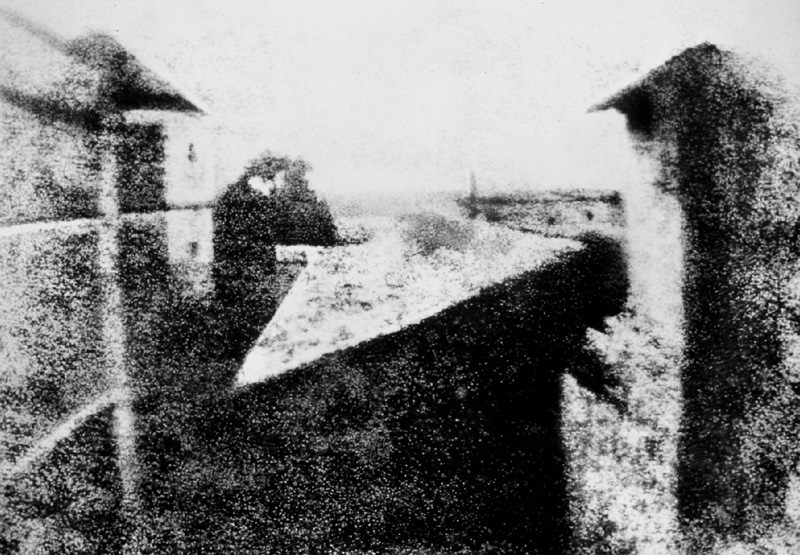
The significance of this photograph lies in its pioneering nature. Niépce’s experiment paved the way for the development of photographic techniques, leading to the invention of the daguerreotype process by Louis Daguerre in 1839 and the eventual widespread use of photography.
“View from the Window at Le Gras” symbolizes the beginning of a new era in visual documentation and communication, as it was the first successful attempt to permanently capture a scene using a camera, marking the birth of photography as an art form and a means of preserving memories and moments in time.
3. Lunch Atop a Skyscraper, Charles C. Ebbets, Thomas Kelley or William Leftwich (1932)
“Lunch Atop a Skyscraper” is an iconic photograph that captures eleven construction workers casually eating lunch while perched on a steel beam high above New York City. The photograph was taken on September 29, 1932, during the construction of the Rockefeller Center’s GE Building.
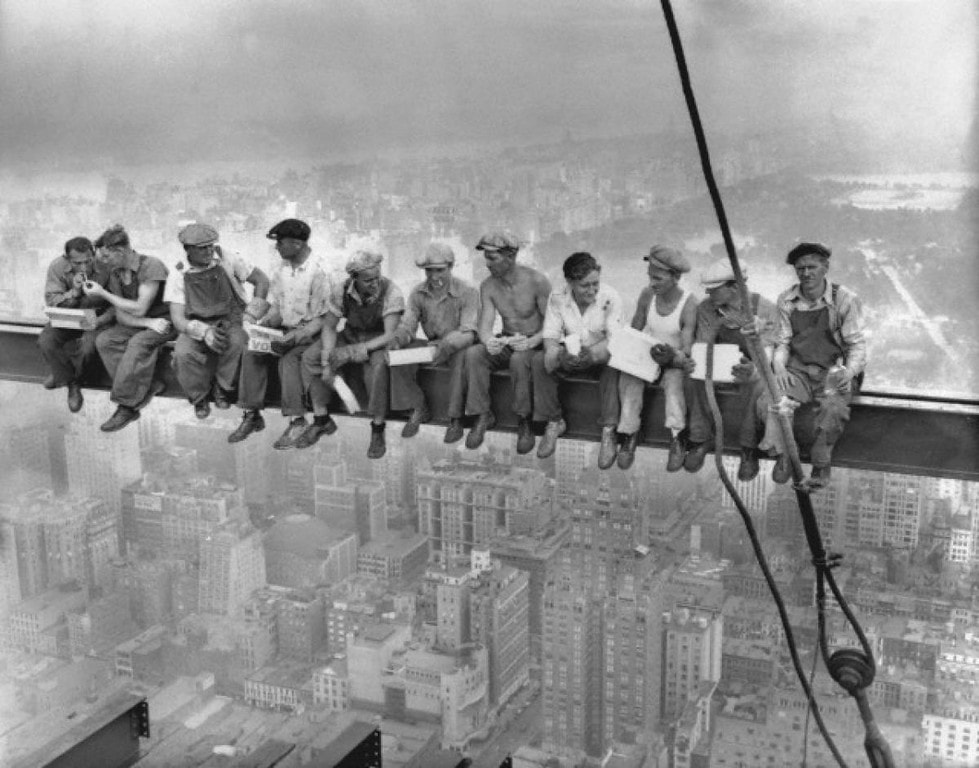
The historical context of the photo is the Great Depression, a severe worldwide economic depression that took place during the 1930s. Despite the economic downturn, construction projects like the Rockefeller Center provided much-needed jobs for many people. The image of these workers sitting nonchalantly on a narrow beam with the city far below is a testament to their bravery and the dangerous working conditions they faced.
The photograph was initially published in the New York Herald Tribune on October 2, 1932, and has since become a symbol of American resilience and the determination to endure and thrive in the face of adversity. The identity of the photographer remains uncertain, with Charles C. Ebbets, Thomas Kelley, and William Leftwich all being credited for the iconic image at various times.
4. Earthrise, William Anders (1968)
“Earthrise” is an iconic photograph taken by astronaut William Anders during the Apollo 8 mission to the moon in December 1968. The photograph captures the Earth rising above the lunar horizon, with the moon’s surface in the foreground.

The historical context of the photo is the space race between the United States and the Soviet Union during the Cold War. The Apollo 8 mission was the first time humans had left Earth’s orbit and traveled to another celestial body. The image of Earth rising above the moon’s desolate landscape was a powerful symbol of humanity’s ability to explore and understand the cosmos.
The photography technique used by Anders was relatively straightforward, given the limitations of the equipment available on the spacecraft. He used a Hasselblad camera with an 80mm Zeiss Planar lens, which was the standard camera for the Apollo missions. The image was captured on color film, and Anders had to manually focus and expose the photograph.
“Earthrise” is considered one of the most influential environmental photographs ever taken. The image helped inspire the environmental movement and the first Earth Day, and it remains a powerful reminder of the beauty and fragility of our home planet.
5. First Aerial Photograph, James Wallace (1860)
“First Aerial Photograph” is a groundbreaking image taken by James Wallace Black in 1860. It is considered the first successful aerial photograph captured from a balloon. The image, titled “Boston, as the Eagle and the Wild Goose See It,” shows a bird’s-eye view of Boston, Massachusetts.

The historical context of the photo is the mid-19th century, a time of rapid technological advancements and growing interest in aerial exploration. The photograph was taken during a balloon ascension by Black and the balloon’s pilot, Samuel Archer King. Black’s work was part of early experiments in aerial photography, which would later become a valuable tool for military reconnaissance and mapping.
The photography technique used by Black was the wet plate collodion process, which was a popular photographic method during that time. This process required the photographer to prepare a glass plate with a collodion solution, sensitize it in a silver nitrate bath, expose it while still wet, and develop it immediately after exposure. This made aerial photography particularly challenging, as the photographer had to manage the entire process in the confined space of the balloon basket.
Related: Top 15 Black and White Photography Quotes
“First Aerial Photograph” is a testament to the spirit of innovation and exploration during the 19th century. It marked a significant milestone in the history of photography and opened up new possibilities for capturing the world from above.
6. Starving Child and Vulture, Kevin Carter (1993)
“Starving Child and Vulture” is a haunting image captured by South African photojournalist Kevin Carter in 1993. The photograph depicts a severely malnourished child crawling towards a food camp during the Sudan famine, while a vulture ominously waits in the background. The image powerfully captures the desperation and hopelessness of the famine crisis in Sudan at that time.

The historical context of the photo is the Sudanese famine of the early 1990s, which resulted from a combination of civil war, drought, and economic mismanagement. The famine claimed the lives of hundreds of thousands of people and left many more severely malnourished. Carter’s photograph brought global attention to the crisis and the suffering of the Sudanese people.
Tragically, Kevin Carter’s life came to an end shortly after winning the Pulitzer Prize for his photograph. Suffering from depression and haunted by the horrors he witnessed as a photojournalist, Carter took his own life in July 1994. His work remains a powerful reminder of the devastating impact of war and famine, as well as the psychological toll on those who document such events.
7. Woman Falling From Fire Escape, Stanley Forman (1975)
“Women Falling From Fire Escape” is a poignant photograph captured by Stanley Forman in 1975. It documents the tragic moment when a woman named Diana Bryant and her two-year-old goddaughter, Tiare Jones, fell from a collapsing fire escape during a rescue attempt amidst an apartment fire in Boston.
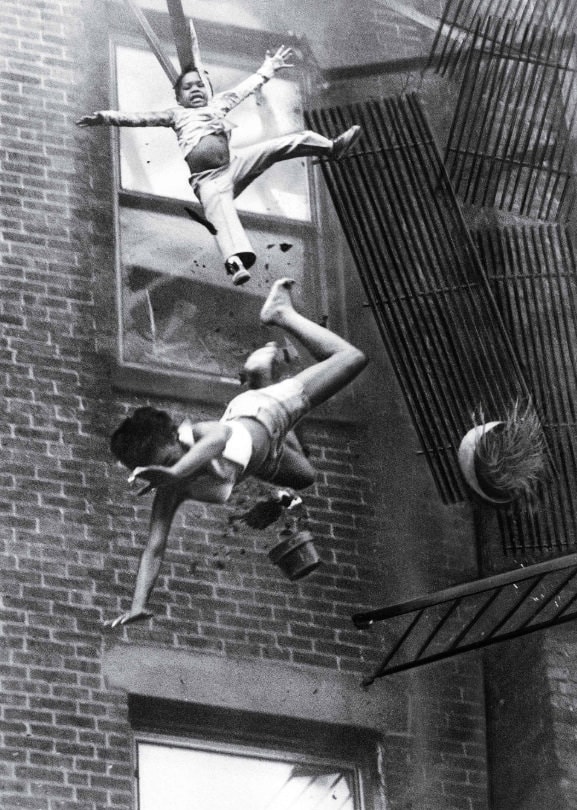
The historical context of the photo is set against the backdrop of the fire at an apartment building in Boston, where firefighters were attempting to rescue residents trapped inside. Forman, a photojournalist for the Boston Herald American, was on-site documenting the event.
The image is an emotionally charged representation of the dangers of inadequate housing and safety standards, as well as the bravery of first responders and the vulnerability of those caught in such situations.
Tragically, Bryant did not survive the fall, while her goddaughter, Tiare Jones, suffered critical injuries but ultimately survived. “Women Falling From Fire Escape” went on to win the Pulitzer Prize for Spot News Photography in 1976 and serves as a powerful visual testament to the profound human stories behind such tragedies.
8. The First American Team Summited Mount Everest, Barry Bishop (1963)
“The First American Team Summited Mount Everest” is a powerful photograph taken by Barry Bishop, capturing the historic moment when the first American team reached the summit of Mount Everest, the world’s highest peak, in 1963.
The historical context of the photo lies in the American Mount Everest Expedition of 1963, organized by the National Geographic Society and the American Alpine Club. The team, led by Norman Dyhrenfurth, included accomplished climbers such as Jim Whittaker, Barry Bishop, and Nawang Gombu.
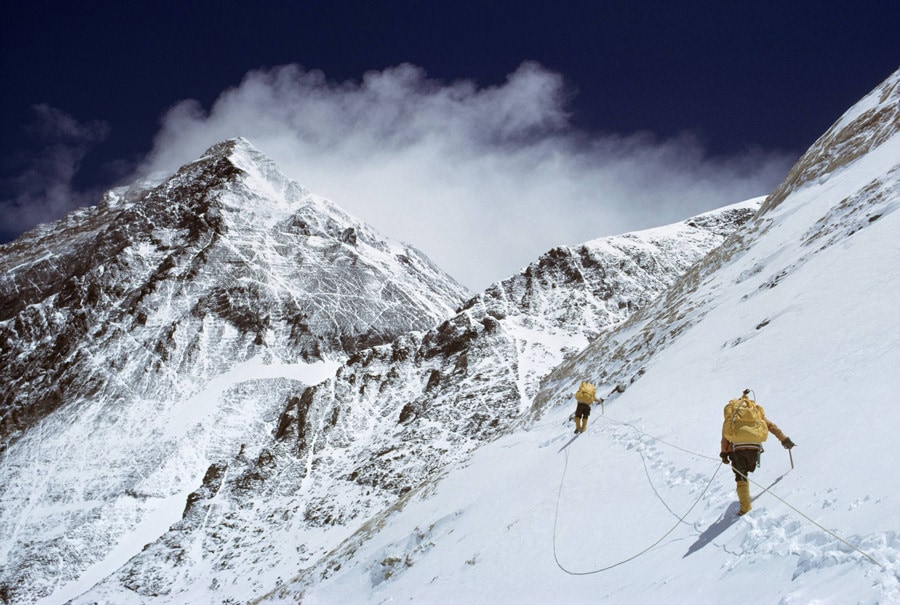
- Jim Whittaker, one of the climbers, became the first American to reach the summit of Mount Everest on May 1, 1963. His successful ascent marked a significant milestone in American mountaineering history and set the stage for the rest of the team to follow.
- Nawang Gombu, a Sherpa climber, achieved a remarkable feat during the expedition by becoming the first person to summit Mount Everest twice. His first ascent was in 1960 with a British team, and his second successful climb was with the American team in 1963.
- Barry Bishop faced severe frostbite in the cold and unforgiving conditions without the modern technologies available to climbers today. He suffered significant injuries, including the loss of all his toes and the tip of a finger, as a result of the harsh environment.
The photograph is not only a testament to the team’s remarkable achievement but also a reflection of the physical and mental challenges faced by climbers during such high-altitude expeditions.
9. The Burning Monk, Malcolm Browne (1963)
“The Burning Monk” is a powerful photograph taken by Malcolm Browne in 1963, capturing the self-immolation of Thích Quảng Đức, a Vietnamese Buddhist monk, as a protest against the persecution of Buddhists by the South Vietnamese government.

The photo was taken on June 11, 1963, in Saigon (now Ho Chi Minh City), Vietnam. Thích Quảng Đức, seated in a lotus position, set himself on fire to bring attention to the plight of the Buddhist community and to call for religious equality and freedom. The act of self-immolation was a desperate and symbolic gesture against the oppressive policies of President Ngô Đình Diệm’s regime, which favored the Catholic minority and discriminated against Buddhists.
Malcolm Browne served as a correspondent and photographer for the Associated Press (AP) during the Vietnam War. His coverage of the conflict and the events surrounding it, including “The Burning Monk” photograph, earned him the 1964 Pulitzer Prize for International Reporting.
In addition to his work in Vietnam, Browne also reported on the civil rights movement in the United States. His photographic documentation of the protests, marches, and pivotal moments of the movement provided valuable visual records of the struggle for civil rights and social justice.
“The Burning Monk” remains one of the most enduring and impactful images of the 20th century, capturing the desperation, sacrifice, and resilience of individuals in the face of injustice and oppression. Malcolm Browne’s courageous reporting and photography continue to be celebrated for their impact on photojournalism and their ability to bear witness to the human experience.
10. Falling Man, Richard Drew (2001)
“Falling Man” is an iconic photograph taken by Richard Drew on September 11, 2001, during the terrorist attacks on the World Trade Center in New York City. The image captures a man falling from the North Tower, which was struck by American Airlines Flight 11.
The photo was taken shortly after the North Tower was hit, as smoke and flames engulfed the building. Many individuals trapped in the upper floors faced the unthinkable choice of remaining in the burning structure or jumping to their deaths. The man in the photograph is one of the numerous individuals who chose to jump, in a harrowing and desperate act.

Richard Drew, an Associated Press (AP) photographer, was covering a maternity fashion show when the attacks occurred. He quickly made his way to the World Trade Center site and began documenting the unfolding tragedy. Drew captured the “Falling Man” image from about a block away using a telephoto lens.
The “Falling Man” photo garnered significant backlash and controversy after its publication. Many people found the image deeply disturbing and disrespectful to the victims and their families. Some felt that the photograph was an invasion of privacy and sensationalized the tragic event. As a result, some media outlets chose to limit or refrain from displaying the image.
The controversy surrounding the “Falling Man” photo sparked a broader debate about the role of photojournalism in documenting and sharing traumatic events. While some argued that the image was an important and powerful documentation of the human cost of the attacks, others believed that it crossed the line into sensationalism and exploitation.
“Falling Man” is a haunting and deeply emotional photograph that encapsulates the horror and despair of the 9/11 attacks. It serves as a reminder of the immense human cost of that tragic day and the indelible impact it had on the world.
11. Pillars Of Creation, Nasa (1995)
“Pillars of Creation” is a stunning photograph captured by NASA’s Hubble Space Telescope on April 1, 1995. It depicts towering columns of interstellar gas and dust located in the Eagle Nebula, which is approximately 7,000 light-years away from Earth in the constellation Serpens.
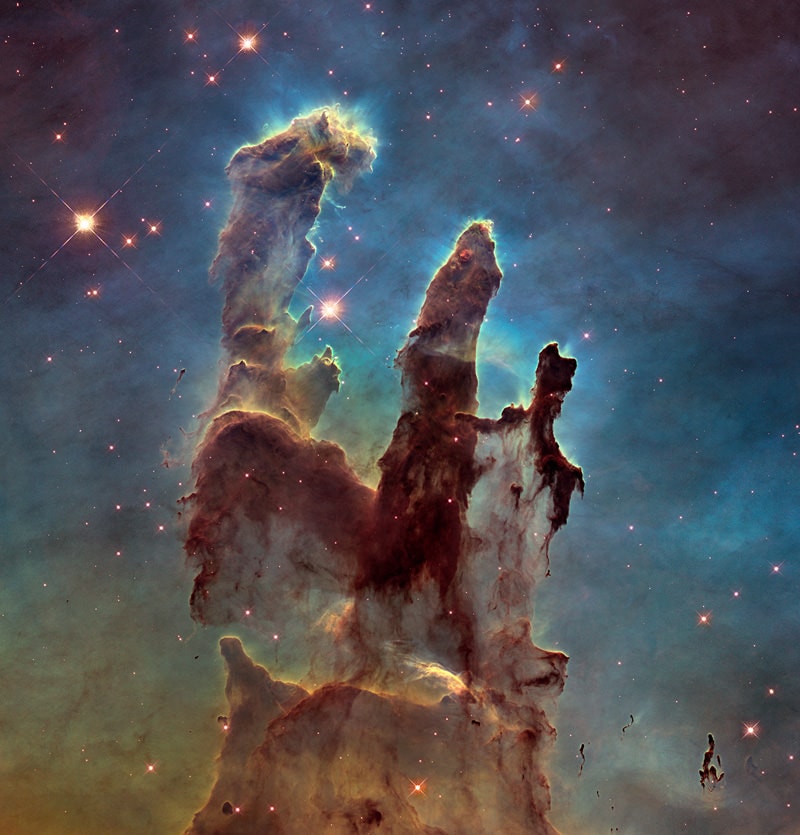
The photograph gets its name from the distinctive, pillar-like structures of gas and dust that are seen in the image. These pillars are dense regions of interstellar material that are being sculpted by the intense radiation and winds from nearby massive stars. The tips of the pillars are regions of active star formation, where dense cores of gas and dust are collapsing under their own gravity to create new stars.
The “Pillars of Creation” image was taken using Hubble’s Wide Field and Planetary Camera 2 (WFPC2) and is composed of three separate images taken in different spectral filters. These images were then combined to create the final color image. The image was taken as part of a project to study star formation in the Eagle Nebula and has since become one of the most iconic and widely recognized images captured by the Hubble Space Telescope.
The “Pillars of Creation” image has captivated the public imagination and has been used to illustrate the beauty and complexity of the universe. It serves as a powerful reminder of the vastness of space and the ongoing processes of star formation and evolution that are taking place throughout the cosmos.
12. The Tetons and the Snake River, Ansel Adams (1942)
The Tetons and the Snake River” is a classic black-and-white photograph taken by Ansel Adams in 1942. It features the rugged and majestic peaks of the Teton Range with the Snake River winding through the foreground. Adams captured this iconic image from an elevated vantage point, providing a breathtaking panoramic view of the landscape.
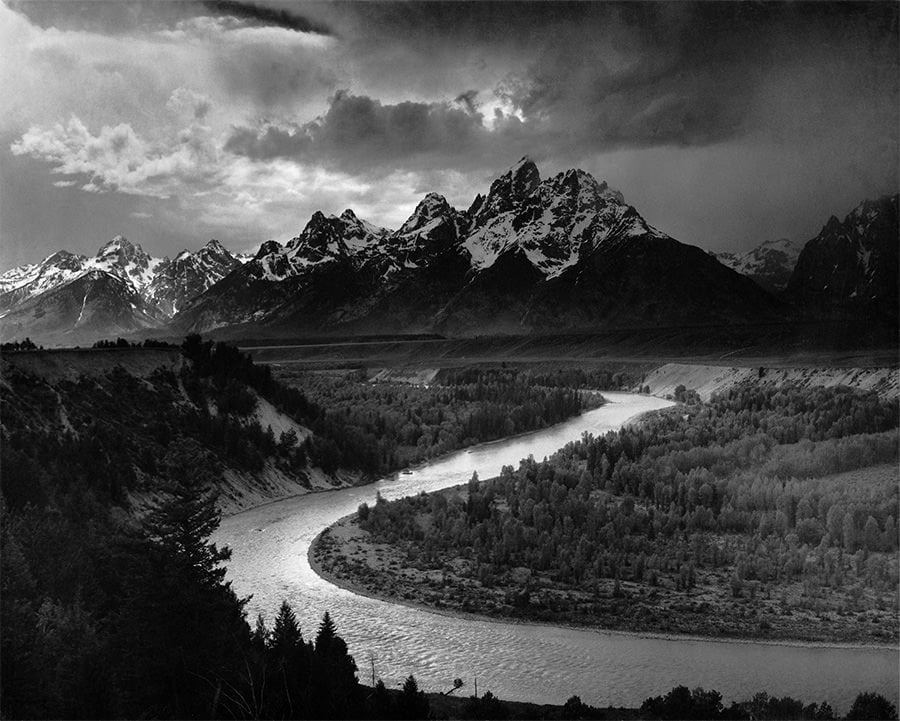
This photograph was taken while Adams was working on a commission for the U.S. Department of the Interior during World War II. The government was creating a series of murals showcasing the nation’s natural beauty for the National Park Service, and Adams was tasked with capturing images for this project.
Adams used a large-format camera to take the photo, which allowed him to capture incredible detail and clarity. He was known for his meticulous attention to composition, lighting, and exposure, and “The Tetons and the Snake River” exemplifies his mastery of the medium. The use of black-and-white photography enhances the contrasts between the mountain peaks, the river, and the sky, creating a dramatic and timeless image.
Ansel Adams is considered to be the godfather of landscape photography, and his work has had a profound influence on the genre, inspiring generations of photographers to explore and capture the beauty of the natural world.
“The Tetons and the Snake River” is a testament to Adams’s skill as a photographer and his deep appreciation for the natural world.
13. Dali Atomicus, Philippe Halsman (1948)
“Dali Atomicus” is an iconic photograph taken by Philippe Halsman in 1948, featuring the surrealist artist Salvador Dalí. The image captures a surreal and dynamic moment, with Dalí suspended in mid-air, surrounded by three cats, a bucket of water, and a floating chair.
This photograph was part of a collaboration between Halsman and Dalí for an article in LIFE magazine. The concept was inspired by Dalí’s interest in atomic particle theory and the idea of suspension. The title “Dali Atomicus” references this theme and alludes to the recent discovery of the atomic bomb.
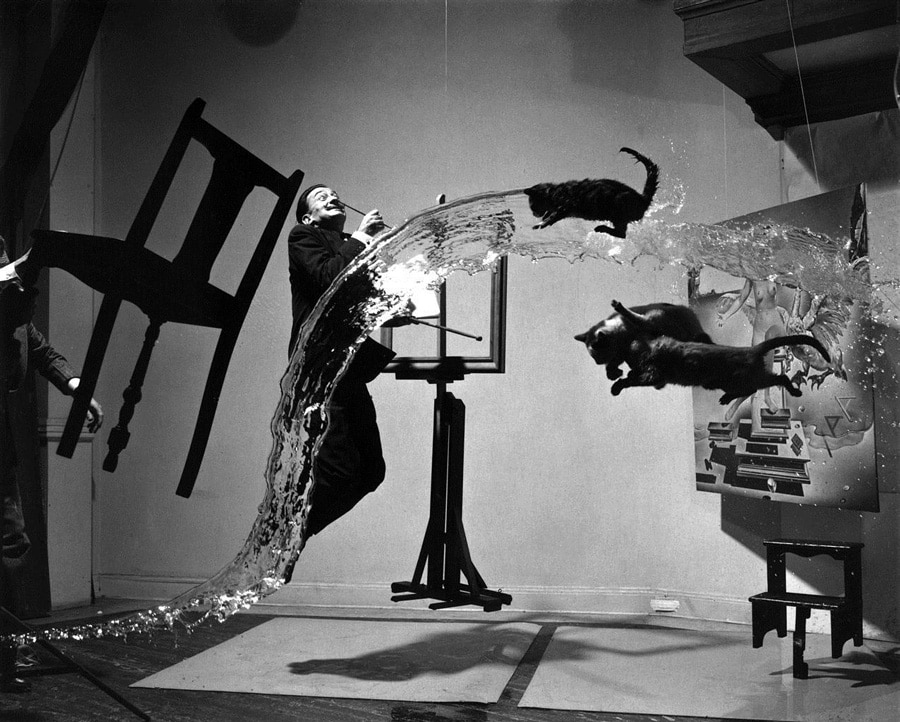
Creating the photograph required a carefully orchestrated setup. Dalí jumped into the air, an assistant threw the bucket of water, and the cats were tossed into the frame. The entire process was meticulously timed, requiring 26 attempts to get the final shot, showcasing the technical skill and persistence required to create this complex image.
“Dali Atomicus” exemplifies the creative partnership between Halsman and Dalí, who worked together on multiple occasions to produce imaginative and unconventional photographs. The collaboration resulted in some of the most iconic and enduring images of the 20th century, illustrating the power of combining photography with the imaginative world of surrealism.
The photograph continues to be celebrated for its technical precision, creativity, and whimsy.
14. First Digital Image, Russell Kirsch (1957)
The iconic photo “First Digital Image,” taken by Russell Kirsch in 1957, is renowned for being the world’s first digitally scanned image. It features a high-contrast image of Kirsch’s three-month-old son, Walden, with dimensions of 176 x 176 pixels.
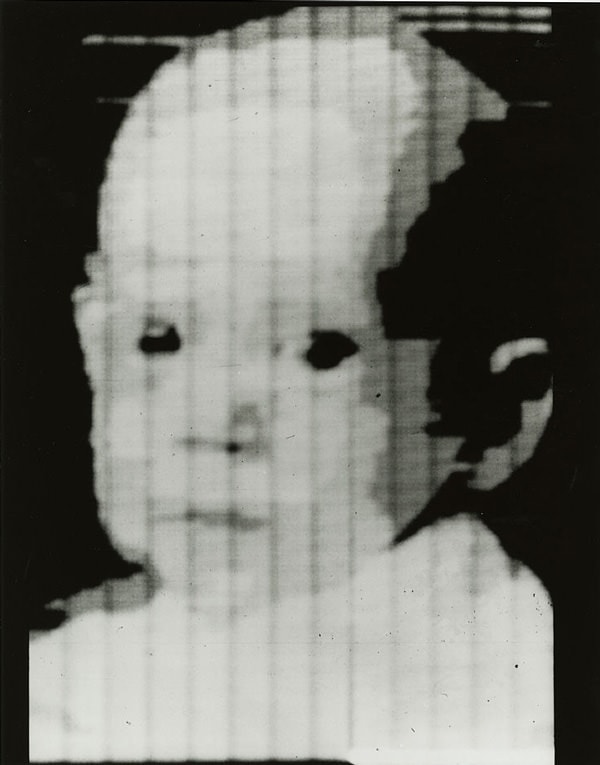
The historical context of the photo is pivotal, as it signifies the dawn of the digital revolution in photography. At the time, Kirsch was employed at the National Bureau of Standards (now the National Institute of Standards and Technology) with the mission to convert images into a digital format suitable for computer processing.
To produce the first digital image, Kirsch utilized a drum scanner—an early form of image scanner—developed by his team. This scanner operated by affixing the photographic print to a rotating drum and utilizing a photo-multiplier tube to gauge the intensity of the light reflected from the image. As the drum revolved, the photo-multiplier tube traversed the surface of the photo, recording the light intensity values and transforming them into digital data.
This groundbreaking achievement demonstrated the feasibility of digital representation for visual information, laying the foundation for modern digital imaging. It has had a profound impact on how we create, share, and consume images, ushering in a new era in visual communication.
It might surprise people to learn that the first digital image was scanned way back in 1957. Especially when you consider that the first digital camera was made in 1975.
Russell Kirsch was an engineer who was part of a team that developed a digital image scanner, creating this image way before digital or lightroom photography was even an idea.
The resolution on this image is low because the computer he used couldn’t store any more data. It might not be one of the most popular images, but it is definitely one of the most iconic.
15. V-J Day In Times Square, Alfred Eisenstaedt (1945)
The iconic photo “V-J Day in Times Square” was captured by Alfred Eisenstaedt on August 14, 1945, the day Japan announced its surrender, marking the end of World War II. The photograph depicts a sailor passionately kissing a nurse in Times Square, New York City, symbolizing the joy and relief felt by Americans as the war came to a close.

The historical context of the photo is significant, as it was taken on Victory over Japan Day (V-J Day), which celebrated the end of the war and the return to peace. Times Square was filled with jubilant crowds, and Eisenstaedt was there to document the spontaneous celebrations.
To capture the moment, Eisenstaedt was on the lookout for scenes that conveyed the excitement and emotions of the day. When he saw the sailor and nurse embrace, he quickly snapped four shots with his Leica IIIa rangefinder camera, capturing the now-famous image in the process.
Related: Creative Photography Ideas
The identities of the sailor and nurse were initially unknown, leading to multiple claims and speculations over the years. The sailor was later identified as George Mendonsa, a U.S. Navy sailor, and the nurse was identified as Greta Zimmer Friedman, a dental nurse. The photo remains a powerful symbol of the joy and relief experienced by the American public at the end of the war.
“V-J Day in Times Square” remains one of the most recognizable and celebrated photographs in history.
Iconic Photos From the History | Conclusion
These 15 photos are some of the most iconic photos in history. We chose them for their ability to tell a story and capture a moment in time. These images have the power to change the way we see the world and can be a source of inspiration for future generations.
